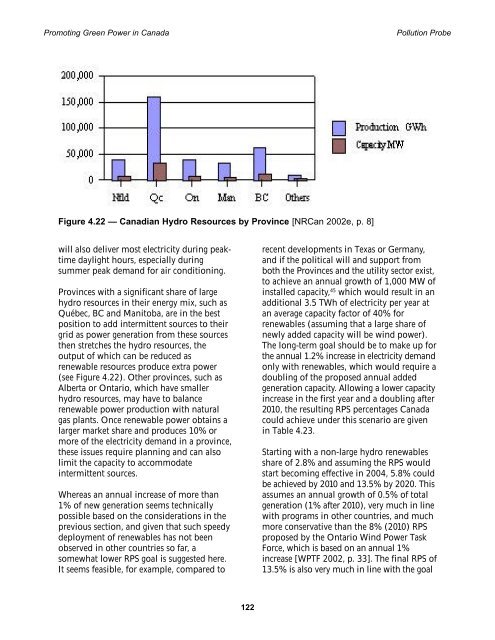Promoting Green Power in Canada - Centre for Human Settlements
Promoting Green Power in Canada - Centre for Human Settlements
Promoting Green Power in Canada - Centre for Human Settlements
- No tags were found...
Create successful ePaper yourself
Turn your PDF publications into a flip-book with our unique Google optimized e-Paper software.
<strong>Promot<strong>in</strong>g</strong> <strong>Green</strong> <strong>Power</strong> <strong>in</strong> <strong>Canada</strong> Pollution ProbeFigure 4.22 — Canadian Hydro Resources by Prov<strong>in</strong>ce [NRCan 2002e, p. 8]will also deliver most electricity dur<strong>in</strong>g peaktimedaylight hours, especially dur<strong>in</strong>gsummer peak demand <strong>for</strong> air condition<strong>in</strong>g.Prov<strong>in</strong>ces with a significant share of largehydro resources <strong>in</strong> their energy mix, such asQuébec, BC and Manitoba, are <strong>in</strong> the bestposition to add <strong>in</strong>termittent sources to theirgrid as power generation from these sourcesthen stretches the hydro resources, theoutput of which can be reduced asrenewable resources produce extra power(see Figure 4.22). Other prov<strong>in</strong>ces, such asAlberta or Ontario, which have smallerhydro resources, may have to balancerenewable power production with naturalgas plants. Once renewable power obta<strong>in</strong>s alarger market share and produces 10% ormore of the electricity demand <strong>in</strong> a prov<strong>in</strong>ce,these issues require plann<strong>in</strong>g and can alsolimit the capacity to accommodate<strong>in</strong>termittent sources.Whereas an annual <strong>in</strong>crease of more than1% of new generation seems technicallypossible based on the considerations <strong>in</strong> theprevious section, and given that such speedydeployment of renewables has not beenobserved <strong>in</strong> other countries so far, asomewhat lower RPS goal is suggested here.It seems feasible, <strong>for</strong> example, compared torecent developments <strong>in</strong> Texas or Germany,and if the political will and support fromboth the Prov<strong>in</strong>ces and the utility sector exist,to achieve an annual growth of 1,000 MW of<strong>in</strong>stalled capacity, 45 which would result <strong>in</strong> anadditional 3.5 TWh of electricity per year atan average capacity factor of 40% <strong>for</strong>renewables (assum<strong>in</strong>g that a large share ofnewly added capacity will be w<strong>in</strong>d power).The long-term goal should be to make up <strong>for</strong>the annual 1.2% <strong>in</strong>crease <strong>in</strong> electricity demandonly with renewables, which would require adoubl<strong>in</strong>g of the proposed annual addedgeneration capacity. Allow<strong>in</strong>g a lower capacity<strong>in</strong>crease <strong>in</strong> the first year and a doubl<strong>in</strong>g after2010, the result<strong>in</strong>g RPS percentages <strong>Canada</strong>could achieve under this scenario are given<strong>in</strong> Table 4.23.Start<strong>in</strong>g with a non-large hydro renewablesshare of 2.8% and assum<strong>in</strong>g the RPS wouldstart becom<strong>in</strong>g effective <strong>in</strong> 2004, 5.8% couldbe achieved by 2010 and 13.5% by 2020. Thisassumes an annual growth of 0.5% of totalgeneration (1% after 2010), very much <strong>in</strong> l<strong>in</strong>ewith programs <strong>in</strong> other countries, and muchmore conservative than the 8% (2010) RPSproposed by the Ontario W<strong>in</strong>d <strong>Power</strong> TaskForce, which is based on an annual 1%<strong>in</strong>crease [WPTF 2002, p. 33]. The f<strong>in</strong>al RPS of13.5% is also very much <strong>in</strong> l<strong>in</strong>e with the goal122
















